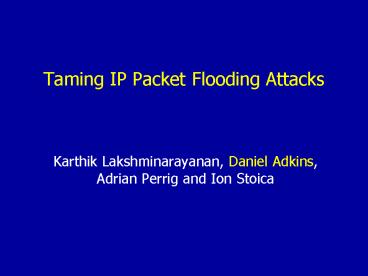Taming IP Packet Flooding Attacks - PowerPoint PPT Presentation
1 / 22
Title: Taming IP Packet Flooding Attacks
1
Taming IP Packet Flooding Attacks
- Karthik Lakshminarayanan, Daniel Adkins, Adrian
Perrig and Ion Stoica
2
In a Nutshell
- Problem Attacker floods a victims network link
- Solution Stop attack traffic before it gets to
the incoming link - Today call ISP to stop the traffic, and hope for
the best! - Our approach Give end-hosts control over which
packets they receive - E.g., enable end-hosts to stop attacks in the
network
3
Why End-Hosts (and not Network)?
- End-hosts can better react to an attack
- Aware of semantics of traffic they receive
- Know what traffic they want to protect
- End-hosts may be in a better position to detect
an attack
4
An Example
- Under congestion, routers drop packets randomly
- ? TCP congestion collapse
- Given control, end-hosts can selectively drop
traffic (e.g., TCP SYNs) to preserve throughput
5
Outline
- Some DDoS Examples
- Argument for End-Host Control
- Possible Approaches
6
Recent DDoS Attacks
- Slammer Worm 25 Jan 2003
- Spread within minutes, saturating access
bandwidth - Other unrelated services were affected
- and that was just the infection phase
Operator response was ineffective
7
UWisc NTP flood
- 800AM Packet flood starts
- 940AM Intra-campus routing failures
- 1100AM Blocked UDP traffic with source port
23457 at WiscNets border routers
8
UWisc Analysis
- Response time was 3 hours!
- Wasnt even a malicious attack, just a bug in
certain NetGear routers - They were luckythey could filter on source port
- Otherwise, it might have been the perfect attack
- Attack traffic comprised legitimate requests
- Attackers were widely distributed
Response was slow
9
Doomsday Scenario
- Some worm is going to get it right
- Infect millions of hosts without being detected
- Launch DDoS that is indistinguishable from
legitimate traffic - Attack rate from each infected host is low enough
that they wont be compelled to patch
Currently no good response
10
Current Approaches
- Network Ingress Filtering RFC 2267
- Stops spoofed addresses
- Rate Limiting (a.k.a. traffic shaping)
- Coarse grained, usually at the receiver
- IP Traceback
- Great if there are only a few attackers
- Null Routing
- Effective if the attack has a good signature
- Anomaly Detection
- Filter out the attack traffic while not affecting
legitimate traffic
11
Give end-hosts fine-grained control over the
packets sent to them in the network
Our Approach
12
Why Give End-Hosts Control?
- End-hosts know better (than network) which
packets are important - Two different responses to same attack
- Keep important service running
- Drop service entirely (bandwidth costs)
- The deeper a router is in the network, the less
it knows about the hosts behind it (e.g. campus
gateway router)
13
Some Useful Defenses
- White-listing avoid receiving packets at
arbitrary ports - Traffic isolation
- Contain the traffic of an application under
attack - Protect the traffic of established connections
- Throttling new connections control the rate at
which new connections are opened (per sender)
14
How Can We Give End-Hosts Control?
- Using Internet Indirection Infrastructure (i3)
- Filters at edge routers
15
Internet Indirection Infrastructure (i3)
- Provides a rendezvous based communication
abstraction (instead of point-to-point) - Each packet has an identifier id
- To receive a packet with identifier id, receiver
R maintains a trigger (id, R) in the network
Sender
Receiver (R)
16
1. White-listing
- Packets not addressed to open ports are dropped
in the network - Create a public trigger for each port in the
white list - Allocate a private trigger for each new connection
H2
H1
17
2. Traffic Isolation
- Drop triggers being flooded without affecting
other triggers - Protect ongoing connections from new connection
requests - Protect a service from an attack on another
services
18
2. Traffic Isolation
- Drop triggers being flooded without affecting
other triggers - Protect ongoing connections from new connection
requests - Protect a service from an attack on another
services
Traffic of transaction server protected from
attack on web server
19
3. Throttling New Connections
- Redirect new connection requests to a gatekeeper
- Gatekeeper has more resources than victim
- Can be provided as a 3rd party service
id
C
t
S
20
Edge Router Solution
- Idea bottleneck is at the edge
- End-hosts control filters at their edge router
- End-hosts also get feedback from the router
- Feasible with todays hardware
The Internet
Filters
21
i3 approach vs. Edge Router approach
- Generality of i3-based approach
- Protocol independence
- Allows seamless redirection to gatekeeper servers
- Deployability of edge-router approach
- Requires change to only the edge routers
- Incrementally deployable
22
Conclusion
- End-hosts are in the best position to react to
DDoS attacks - End-hosts know about the semantics of the traffic
they receive - Our approach
- Give end-hosts control over which packets they
receive - Future work
- What extent of control should be given to hosts?
- How do we protect core of the network from
attacks?






























